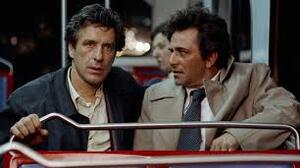Mikey and Nicky

Traveling extensively with her parents’ theater company, Elaine May was immersed in the arts from an early age, absorbing the nuances of storytelling and developing a profound understanding of human nature. In the early 1950s, she met Mike Nichols while both were students at the University of Chicago, igniting a lifelong collaboration that led to the formation of the iconic comedy duo Nichols and May. Their groundbreaking improvisational style and sharp social commentary resonated with audiences, propelling them to Broadway and national prominence with a sophisticated yet satirical approach that blurred the boundaries of traditional gender roles.
Following the amicable dissolution of the legendary team, May transitioned to filmmaking, bringing her distinctive voice and idiosyncratic perspective to the director’s chair at a time when female filmmakers remained a rarity. Her directorial debut, the razor-sharp A New Leaf (1971), follows a spoiled aristocrat who schemes to marry a wealthy woman and then dispose of her, showcasing May’s versatility as writer, director and star. She continued her exploration of complex relationships in The Heartbreak Kid (1972), a keenly observed study of a man’s impulsive marriage and subsequent infatuation with another woman on his honeymoon – an insightful and critically lauded success that further cemented her reputation.
In 1973, May embarked on her most ambitious and personal project to date, departing from her comedic roots to plunge into the gritty, violent underworld of two small-time mobsters. Her pursuit of authenticity led to an unconventional shooting style, characterized by extensive improvisation and multiple takes, resulting in a film that serves as both character study and meditation on loyalty and the human condition. Unfolding over the course of a single, tension-filled night, the resulting Mikey and Nicky is an unforgettable nocturnal odyssey that offers an unfiltered examination of male friendship and the cost of betrayal.
The film opens with Nicky (the brilliant John Cassavetes), a low-level gangster holed up in a dingy hotel room, gripped by paranoia and fear after embezzling funds from his bosses in the mob. Convinced that a contract has been placed on his life, he, in his desperation, reaches out to his childhood friend and fellow mobster Mikey (the equally brilliant Peter Falk) for help. Despite the late hour and inherent danger, Mikey responds to Nicky’s plea and arrives at the hotel to find his old friend in a state of disarray, swinging wildly between trust and suspicion, gratitude and hostility.
Mikey, maintaining a façade of calm and control, attempts to steady Nicky’s frayed nerves, proposing a plan to help him escape the city and the impending threat on his life. Their journey takes them through a series of dimly lit locales throughout the neighborhood, each backdrop serving to deepen the film’s examination of their bond – one riddled with unresolved tensions and buried resentments. An impromptu visit to a cemetery, where Nicky pays his respects to his deceased mother, becomes a poignant moment of reckoning, forcing them to wrestle with their shared past and Nicky to confront his own looming mortality.
With the two friends drawn closer by this moment of reflection, Nicky suggests they visit a female acquaintance – an invitation Mikey initially accepts but soon regrets as Nicky’s reckless behavior escalates. His thoughtless humiliation of Mikey fractures their fragile camaraderie, leading to the film’s emotional centerpiece: a volatile confrontation where years of suppressed grievances erupt, and shift the pair’s dynamics between rage, accusation, and pleading vulnerability. May captures their spiraling argument with painful authenticity, using a cinema verité style that renders each hesitation and glance stunningly resonant – a tour-de-force blending of improvisation and raw intensity that transcends mere performance.
As the dawn nears and the last remnants of friendship erode, the narrative culminates in its harrowing climax. In a final act of desperation, Nicky seeks refuge at Mikey’s suburban family home, pounding on the locked door as his fate closes in. The ultimate betrayal unfolds as Mikey, standing on the other side, refuses to let him in, leaving his former friend pleading for help, and his life, as the hitman approaches. In this gut-wrenching moment, May forces the audience to confront the brutal realities of a friendship tainted by self-interest and the moral ambiguities that corrode tenuous human connection.
The production of Mikey and Nicky was as tumultuous as the relationship it portrays. May’s meticulous artistic vision led to significant budget overruns and scheduling delays, straining her relationship with Paramount Pictures. Tensions reached their peak when, in an effort to protect her creative vision and prevent studio interference, she defiantly hid reels of film, sparking a prolonged legal dispute and accusations of breach of contract. The film’s contentious production history overshadowed its achievements, and upon its belated release – more than three years after principal photography began – it received mixed reviews. Some critics praised its performances, while others took issue with its pacing.
Despite its troubled production and initial reception, Mikey and Nicky has undergone a significant critical reappraisal in the decades following its theatrical release, now regarded as a pioneering work that defies conventional genre classification. Lauded for its raw, unvarnished portrayal of flawed characters and its seamless fusion of scripted and improvised dialogue, the film remains as unsettling as it is compelling. This renewed appreciation underscores its willingness to challenge cinematic conventions, and its legacy – marked by both artistic triumph and behind-the-scenes turmoil – continues to inspire and provoke thoughtful discourse on the art of filmmaking.
Elaine May’s unwavering commitment to her artistic integrity, even in the face of industry resistance, solidifies her status as a trailblazing filmmaker whose creative influence is deeply etched in American cinema. Her fearless examination of human relationships and her innovative, actor-driven approach to directing have produced essential works that continue to shape a generation of filmmakers striving to capture a style that is both unflinching and profoundly human. The enduring relevance of May’s filmography and the ongoing reassessment of her contributions highlight the importance of preserving films that defy convention and reexamining stories that push the boundaries of cinematic storytelling.
